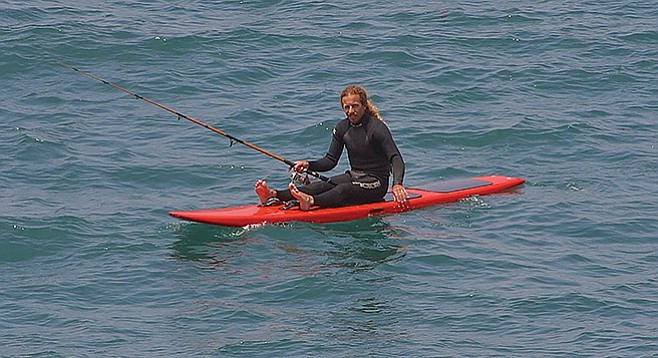 Facebook
Facebook
 X
X
 Instagram
Instagram
 TikTok
TikTok
 Youtube
Youtube

It is finally surfboard fishing season in Pacific Beach. The surf is small (unfortunately for surfing) and the water is warm (over 70 degrees). Usually the conditions are favorable only two months a year, in August and September.
The best time for surfboard fishing is early in the morning, before the wind comes up. The goal is to take the least amount of fishing gear possible, usually a fishing pole and a net. Right now there are more legal size calico bass (14˝) out there than this fisherman can ever remember. Plus a lot of small barracuda, kelp bass, and a few white sea bass. But they need to be at least 28˝ long, and most of the ones right out front are not that big. Then there is the California halibut. They are the best eating fish out there.
But before we get too excited, there is the South La Jolla State Marine Preserve to consider. From the maps, it appears to begin at Diamond Street (two blocks north of Crystal Pier) and go almost straight out along the pier.
But this is not correct. In fact, from the end of Diamond Street, the south boundary of the preserve is due west, at 270 degrees. Interestingly, the large orange buoy in front of Law Street lies directly along the boundary line. This means that much, much more of the ocean in front of Pacific Beach is not inside the reserve. And there is a small kelp bed a few hundred yards out from the orange ball, which is outside of the reserve.
Anyone with a long surfboard (and a valid fishing license) should consider trying this sport. Since you will be soaking in salt water, only use cheap reels, as they will not last very long. A bungee cord is necessary to hold the rod to the surfboard on the way out and back in. A net is only necessary if you plan on bringing back fish, but most surfboard fishermen are catch-and-release. There is a good reason for that. It is because of the sea lions that are constantly moving between kelp beds. They are very curious and will come right up to you, but as long as you do not have a bag of fish attached, they (probably) will not hurt you.
If you catch a big calico bass it might be worth bringing home. They are the original fish-taco fish from Mexico.


It is finally surfboard fishing season in Pacific Beach. The surf is small (unfortunately for surfing) and the water is warm (over 70 degrees). Usually the conditions are favorable only two months a year, in August and September.
The best time for surfboard fishing is early in the morning, before the wind comes up. The goal is to take the least amount of fishing gear possible, usually a fishing pole and a net. Right now there are more legal size calico bass (14˝) out there than this fisherman can ever remember. Plus a lot of small barracuda, kelp bass, and a few white sea bass. But they need to be at least 28˝ long, and most of the ones right out front are not that big. Then there is the California halibut. They are the best eating fish out there.
But before we get too excited, there is the South La Jolla State Marine Preserve to consider. From the maps, it appears to begin at Diamond Street (two blocks north of Crystal Pier) and go almost straight out along the pier.
But this is not correct. In fact, from the end of Diamond Street, the south boundary of the preserve is due west, at 270 degrees. Interestingly, the large orange buoy in front of Law Street lies directly along the boundary line. This means that much, much more of the ocean in front of Pacific Beach is not inside the reserve. And there is a small kelp bed a few hundred yards out from the orange ball, which is outside of the reserve.
Anyone with a long surfboard (and a valid fishing license) should consider trying this sport. Since you will be soaking in salt water, only use cheap reels, as they will not last very long. A bungee cord is necessary to hold the rod to the surfboard on the way out and back in. A net is only necessary if you plan on bringing back fish, but most surfboard fishermen are catch-and-release. There is a good reason for that. It is because of the sea lions that are constantly moving between kelp beds. They are very curious and will come right up to you, but as long as you do not have a bag of fish attached, they (probably) will not hurt you.
If you catch a big calico bass it might be worth bringing home. They are the original fish-taco fish from Mexico.
Comments